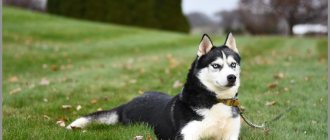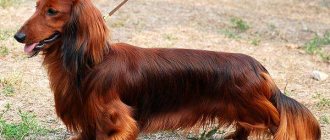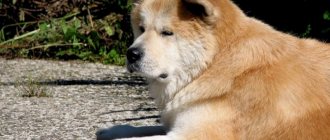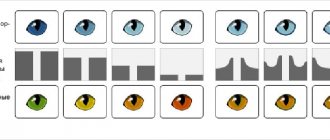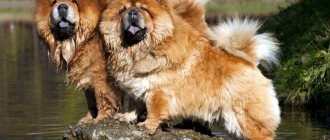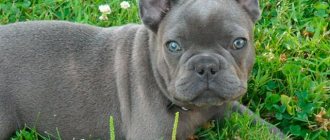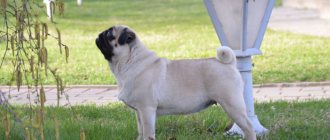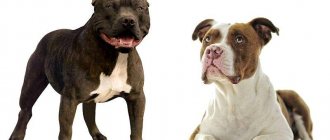1873
Author of the article
Ekaterina Andreeva
Reading time: 8 minutes
A A
When you try to find Chihuahua colors from photos, the list is truly surprising. It’s easy to get lost in all the diversity that opens up to your eyes, which is what some breeders take advantage of, not failing to indicate in the advertisement that their charges are truly unique. I suggest you look into this issue and somewhat systematize the abundance of information in your head.
Prohibited color
I think it’s better to start right away with the colors, which are prohibited by dog handlers. An ordinary Chihuahua lover who does not understand the breed, when viewing a photo, may be touched by cute dogs with a color reminiscent of marble. I agree, a small dog with such spots and stains actually looks cute.
This merle color is achieved due to the uneven coloring of the hairs. It doesn’t matter what kind of stains a smooth-haired or long-haired animal has - they can be black or brown . The main thing is that part of the pile differs in palette. For the first time, breeders had to deal with such a rare dog in the 90s in America.
IMPORTANT: I do not recommend focusing on those breeds of dogs that are also marbled. This list includes the dachshund, collie, and Australian shepherd.
Chihuahuas are a completely different story. The puppy may well be deaf, blind, or have other eye problems. In especially severe cases, the animal is born without organs of vision and hearing. Sometimes it can be sterile - I think under the circumstances it's clear why that's a good thing.
Often a dog of this color dies at birth. Especially at risk are the so-called “double merles” - that is, animals in which both parents were defective. Such animals sometimes face problems related to bones and heart. In addition to those I listed above.
Officially accepted Chihuahua breed standards
The black Chihuahua, except for the shade, is no different from representatives of the breed of other colors. There is an officially recognized breed standard:
- The skull is round, there is no fontanel, but according to the standard, a slight depression is allowed.
- The nose is upturned and of short length. The lobe is traditionally black, but another shade is acceptable.
- The muzzle is short, tapering towards the nose.
- The eyes are large and round.
- The ears are triangular in shape and wide open.
- Straight or scissor bite.
- The neck is curved at the top. The short length is a disadvantage.
- The chest is wide and deep, the ribs are smoothly rounded.
- The tail is of medium length, curved towards the loin and set high.
- The front legs are straight, the hind legs are well muscled.
Important! The length of an animal's body is always greater than its height.
Based on coat type, the following types of Chihuahuas are recognized:
- Smooth-haired. The coat is short, smooth, and may or may not have an undercoat. The white smooth-haired Chihuahua is often found.
- Shorthair. Is an unacceptable coat type.
- Long-haired. The coat is thin, slightly wavy or straight, and can sometimes be fluffy. Near the ears it forms waves reminiscent of fringe.
The breed standard is officially approved, and individuals must comply with it
White and black colors
A dark and light palette of this kind is usually considered a classic, but in the case of a Chihuahua, things are a little different:
- The black dog is, oddly enough, rare. I mean, in its purest form. For, as a rule, there is a small white spot in the area of the chest and paws.
- White – this color in mono version is also quite rare.
- Spotted – but this kind of animal can be found more often. This is, for example, a light dog and black spots included. They are contrasting, large, located on the head and torso. Or it is a dark representative with small white spots, as I wrote about above.
Brief history of origin
It is still not known for certain how exactly the Chihuahua breed appeared. It is only confirmed that it is of natural origin.
Most researchers agree that Chihuahuas originated in what is now Mexico. This is evidenced by wall paintings and excavation results.
The dogs were originally mute, they were called “techichi”. These were sacred animals that lived in the Taltec tribe.
There are also theories that they came from the Incas and Mayans.
One way or another, it was the Techichi that were the ancestors of modern Chihuahuas.
What are they like today?
Chihuahua puppies mature psychologically very early, so at the age of about a year they are already fully formed animals in habits, behavior and character. The intelligence of such dogs is unusually developed. In addition, they have a special instinct for people, easily guessing their mood and adapting to the state of those around them. These creatures quickly adapt to the character traits of their owners, as well as the surrounding environment.
One of the useful mental traits of such pets is curiosity. In addition, they often turn out to be very useful for owners in everyday life. For example, they take upon themselves the responsibility of bringing various necessary small items and things to their patrons. However, these dogs are not so simple. Using their ingenuity and natural charm, they often endear their owners to such an extent that they psychologically gain the upper hand over them and try to manipulate them in their own interests.
How to choose a future pet
Choosing a puppy begins with selecting a kennel with a good reputation, where the purchase should take place. It is best to read reviews of the shelter and talk to people who have used it, as this will give you a definite impression.
Useful tips for choosing Chihuahua puppies:
- When starting to choose, you should not give in to the temptation and take the puppy that you like best based on its color and eye color. Initially, you need to pay attention to his state of health and purebred. There is no need to choose pets with discharge from the eyes, an unpleasant odor from the mouth, traces of alopecia and unkempt fur.
- It is also better to avoid overly melancholic and cowardly animals, especially if it is an adult dog. It is best to give preference to the pet that was the first to go to the meeting.
- Buying a mixed breed in order to save money is also not the best idea. The overwhelming percentage of such dogs have congenital pathologies, and they are also characterized by unstable psyche.
- When choosing, the gender of the pet also plays an important role. Chihuahua girls are more capricious, while boys, on the contrary, are obedient. Girls, unlike boys, mark their territory less, which is an undeniable advantage.
- You should also pay attention to the weight of your pet. A puppy at the age of 3 months should not weigh less than 0.5 kg and more than 2.7 kg.
Important! Having decided on a specific pet, you should check whether the breeder has documents for it. Documents on vaccinations performed are also subject to verification.
It is important to be responsible when choosing a puppy so as not to purchase an unhealthy pet.
The black Chihuahua is a unique pet that has not only attractive external features, but also a wonderful character, of course, subject to proper training. You just need to choose a dog that is suitable in character, who will eventually become a reliable friend.
Character traits
Despite their miniature size, these animals are distinguished by their stable psyche and high intelligence. They are not characterized by such traits as hysteria or cowardice. They are very proud, curious and arrogant.
Among other things, black and tan Chihuahuas, like other representatives of this breed, are very touchy. They cannot stand it when people communicate with them in a raised voice. Nevertheless, they will always meet the owner halfway to resolve a conflict situation.
These are very active temperamental creatures who are not shy about expressing their emotions. They are very loyal to their owners and do not tolerate stress very well. Due to their sociability, Chihuahuas get along well with children. But playing with them is fraught with injury for a small dog. Therefore, representatives of this breed need to avoid communicating with children.
Price range
The cost puppy depends on what class it belongs to :
- Show class . Exhibition copy, price varies depending on the title of the parents. From 50 to 200 thousand rubles.
- Breeding class . The most popular class of the breed. The price varies from 40 to 60 thousand rubles.
- Pet class . Dogs for the soul and for home keeping. They have no title or pedigree. The price varies from 10 to 20 thousand rubles.
Purple Chihuahua girls are more expensive than boys.
This is due to the possibility of obtaining further offspring.
Walks
Some inexperienced owners mistakenly believe that sneezes do not need to be taken outside. In fact, despite their smaller size, these active dogs need regular walks. This will give them the opportunity for full emotional and physical development.
White, chocolate, blue and black and tan Chihuahuas can walk at air temperatures not lower than -10 and not higher than +30 degrees. Otherwise, the animal is at risk of frostbite or heatstroke. You need to gradually accustom your animal to the street. For your first walks, it is recommended to choose quiet places away from cars and large crowds of people. It is important that your pet is not afraid of anything. After all, a feeling of fear can create serious problems and prevent further acquaintance with the outside world.
Over the course of several weeks, the duration of walks should not exceed twenty minutes. During a walk, it is important to prevent your pet from getting wet or freezing. He also needs to be protected from communication with larger relatives, who could inadvertently injure the tiny dog. In public places it is better to keep your pet on a leash. Because passers-by may simply not notice it and accidentally crush it. If you encounter obstacles on your way, such as deep puddles, steep climbs or steps, you need to pick up the sneeze in your arms and move it from place to place.
Still, forecasts are possible
Is it not possible to predict the outcome one hundred percent? But there are also advantages to this. And if everything had been different, we would not have been able to observe the diversity of lilac-colored Chihuahuas (photos are presented to the reader in the article), if everything turned out to be too predictable and simple.
However, predictions are still possible, because the laws of genetics have not yet been repealed.
The rules are:
- having crossed lilac and blue parents, one should expect offspring of only the indicated colors, there simply should not be any other shades;
- the lilac pair will produce puppies of exactly this range;
- lilac and gray parents are most likely to produce cubs with a cream-colored coat, with lilac or gray tan being a possibility.
The rules are the rules, but it should be borne in mind that in one litter obtained from two purebred Chihuahuas, there may be puppies that are not the same, but of very different colors.
About choosing a lilac puppy
Does the color of a dog's coat affect the quality of the breed? This question is important. Especially if the intended owner wants to participate with his pet in prestigious exhibitions in the future. In fact, the shade of the hair is just one of many signs, the same as the shape of the body and head, the condition of the teeth and other parameters. So, answering the question posed, it is necessary to note: in general, the lilac color of a Chihuahua (photos prove that this color is quite original) does not affect the qualitative characteristics of the breed.
Although the same once mutated gene that was mentioned earlier is not considered the norm for nature. And any deviation from standard natural indicators can affect the health of the animal. Therefore, such Chihuahuas can be sickly and produce weakened offspring. Also, such a deviation from the norm in some cases spoils the character of the pet. But with proper maintenance, care and breeding of such dogs, all the unpleasant aspects regarding the mutant gene disappear by themselves. The main thing for the owner is to have the necessary knowledge and skills. And in the absence of such, you should listen to the recommendations of experienced specialists.
Training
Just like any other dog, sneezing needs training. He must know several basic commands, including “Come”, “Fu” and “Place”. It is advisable to start raising a puppy immediately after it arrives in your home. You should not allow your baby to do things that would be prohibited to an adult pet. For example, if you don’t want your dog to lie on your sofa later, don’t let him there from the first days.
Don't pamper your miniature pet too much. Otherwise, the tiny animal will very quickly turn into an arrogant, smug and poorly controlled creature. To develop the correct behavioral skills, you need to start socializing the puppy as early as possible. It is important that he is given the opportunity to communicate with his relatives and meet new people... many sneezes are prone to barking for no reason. Therefore, you need to immediately pay attention to this moment and wean your baby from this habit.
The effect of the merle gene on the health of Chihuahuas
Representatives of Merle Chihuahuas have recently appeared in some American nurseries. This coloration has never been part of the species' history. According to geneticists, Chihuahuas were given the merle color of a dachshund or sheltie.
In addition to the fact that the breed is susceptible to joint diseases, marbled species, in addition to exotic coloring, also have their own pathologies (even with a single Mm):
- lens dislocation and corneal dystrophy;
- high mortality of newborn puppies;
- high probability of giving birth to crippled puppies (without an eye or ear);
- birth of infertile animals;
- gross anomalies of the sensory organs;
- sperm deficiency.
You should provide your pet with a calm walk without straining the joints, and beware of overheating and cooling. In hot weather, allow yourself to drink more water.
Breed diseases
Chihuahuas (black, fawn, brindle and any others) are distinguished by excellent health. They have a very strong immune system, so they rarely get sick. But, like any other creature, these little ones are prone to some breed ailments. They often have problems with vision and the cardiovascular system.
These miniature creatures are often diagnosed with dislocations, as well as dysplasia of the hip or elbow joints. In addition, chocolate, Isabella, or black Chihuahua puppies suffer from hypoglycemia.
Why is it dangerous to breed such dogs on purpose?
The merle coloration is interesting and unique, which is why the puppies attract a lot of interest from buyers. However, breeders should be aware of the risks associated with inappropriate selection of breeding pairs.
Since the merle gene does not affect red coloration, mating of merle and dark (red) pairs of collies and Scots is avoided - puppies of an undesirable color may be born. Most animals have a black coating on a red background, and only on this are marbled spots visible. Then the red color may seem dirty.
On a note! Among Border Collies and Mudi you can find dogs with pure red, cream or biscuit colors (Golden, Labrador). In their case, the merle color may not appear in the coat, but only in the eye color. Meanwhile, blue eyes in a white or fawn Mudi are a defect - a reason for disqualification.
The dark side of the gene
Sometimes the merle color in dogs is not noticeable, you may not notice the crossing with another merle, but this should not happen, because the merle gene has its own dark side. If you cross a merle with an unmarked individual, statistically half of the puppies will be merle and half will not. Or half the children will be regular merle, a quarter will be standard merle, and a quarter will be double merle. Thus, crossing merles does not increase the chances of producing regular merles, but rather increases the likelihood of producing deaf or blind puppies.
Additional Information . Marbled pit bulls, cocker spaniels, and chihuahuas appeared in America. In these breeds, this coloration is the result of experimental matings (in the case of the Chihuahua, probably with a Sheltie). The Merle Spitz is also bred using a gene mutation. The reason for this practice, unfortunately, is the financial motivation of breeders.
List of genetic problems associated with the M gene
Breeds that have the mutation:
- dachshund;
- Great Dane;
- pug;
- French Bulldog;
- coolie;
- Australian Shepherd;
- long-haired and short-haired Scottish Shepherd;
- corgi cardigan;
- Border Collie;
- leopard dog.
Leopard Hound
When a breeder is not sure whether his pet is a merle, it is recommended to have a test done. Homozygous individuals (MM) are sometimes born:
- with deformity or complete absence of eyes or ears;
- partially or completely deaf (54.6% of MM-homozygotes and 36.8% of MM-heterozygotes were found with hearing problems of varying severity - from mild to complete deafness);
- barren;
- predisposed to eyeball abnormalities (flattened fundus, twilight blindness, risk of developing cataracts).
Important! Deafness has not been found in the Catahoula leopard dog, even in the homozygous system (MM).
Dominant homozygotes arise only from the combination of two individuals - carriers of the M gene. In many European countries, their mating has been banned.
Feeding recommendations
Representatives of this breed can be given both industrial and natural food. In the first case, preference should be given to super-premium products produced by trusted global manufacturers who value their own reputation. It is important to ensure that the brand you choose does not contain wheat, corn, artificial colors or preservatives.
Those who prefer to feed their black Chihuahua with natural products need to remember that the basis of his diet should be meat. It could be beef, lamb or poultry. A couple of times a week, the meat component can be replaced with low-fat sea fish and offal. It is also advisable to include cereals, vegetables, fruits, cottage cheese, kefir, yogurt and chicken eggs in the menu of a miniature pet. It is strictly forbidden to treat these little ones with sweets, smoked meats, pickles and tubular bones.
What are they like?
Can a Chihuahua's fur really be purple? If we consider the question in the classical sense, then this is a great exaggeration. Those dogs that are usually called lilac Chihuahuas turn out to be fawn, red-sable or light chocolate, but with a lilac tint. Other shades of similar color schemes are possible in the most interesting and unexpected combinations. Dogs of this breed with similar colors are often called Isabella or pink. This is the case when the purple shade turns out to be very light.
It is allowed for such dogs to have small white patches of fur on the chest and on the tips of the paws. Tricolor is also possible, but wool with a lilac tint should still be predominant in these specimens. There may be white spots of significant size, but not on the back or sides.
In the photo above you can see a magnificent specimen of a lilac-fawn Chihuahua.
